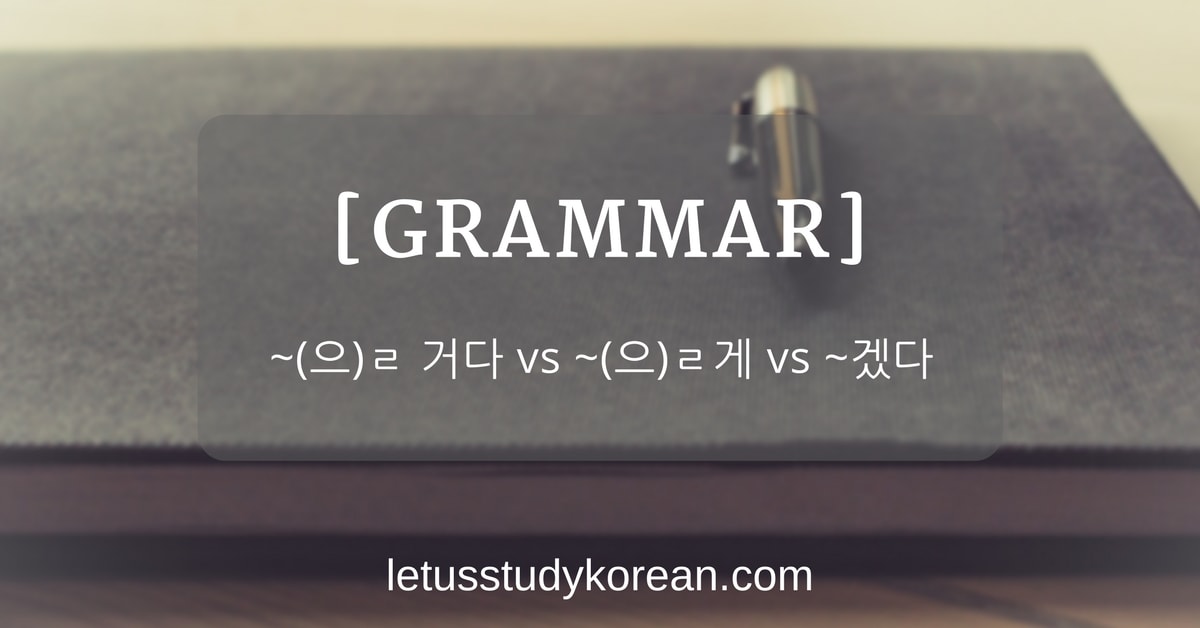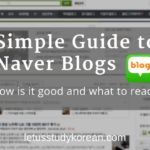(Estimated reading time: 8 minutes)
It’s been a very long time since my last blog post about grammar nuances (or about anything at all…) – the last one was ~(으)ㄹ 것 같다 VS ~(으)ㄴ/는 것 같다! So I’m back again with another blog post on grammar nuances, this time comparing 3 similar particles.
~(으)ㄹ 것이다, ~(으)ㄹ게 and ~겠다 are all in the future tense but there are distinct differences across all 3. We would attach these particles to any verb or adjective to express it in the future tense. We can’t attach these particles to nouns!
I used to be confused with all three of them, thinking they can be used interchangeably. I couldn’t be more wrong!
We’ll look at the important differences in usage of each grammar particle, comparing them and the nuances.
For starters, (으)ㄹ 것이다 is more commonly known as ~(으)ㄹ 거예요/(으)ㄹ 거야.
Be sure to leave comments if you have anything to add/clarify!
Things to note
1a. ~(으)ㄹ 것이다 can be used in first, second and third person
If we want to express anything in the future tense, adding ~(으)ㄹ 것이다 is the simplest and safest way to do it. ~(으)ㄹ 것이다 can be used in the first person, second person and third person, unlike the other two particles.
Examples:
이따가 점심(을) 먹을 거예요.
I will eat lunch later.
내일 학교(에) 갈 거예요?
Will you go to school tomorrow?
*~(으)ㄹ 것이다 is usually used to ask questions when used in the second person.
형(은) 저녁(을) 먹고나서 게임(을 ) 할 거예요
Elder brother will play games after having his dinner.
1b. ~(으)ㄹ 것이다 can be attached to both verbs and adjectives
Other than nouns, which technically don’t have future forms, ~(으)ㄹ 것이다 can be used in conjunction with both verbs and adjectives.
As can be seen, ~(으)ㄹ 것이다 is the most general and common way to express future tense.
Examples:
For verbs, refer to 1a for the example
다음 주에 회의가 있어서 바쁠 거예요.
There’s a meeting next week so I’ll be busy.
엄마가 만든 김치찌개는 맛있을 거예요.
The Kimchi stew Mum made is really good so it will be delicious.
1c. ~겠다 means a strong will or intention to perform an action and can only be used in the first person
Just like ~(으)ㄹ게, ~겠다 can only be used in the first person. However, the difference is that ~(으)ㄹ게 doesn’t necessarily imply the speaker’s determination to follow through with the action.
To emphasise one’s strong will or intention to follow through with an action, use ~겠다 instead of ~(으)ㄹ게.
~겠다 is also used very often in formal and professional settings, as you would have noticed while watching Korean dramas or variety shows.
Examples:
앞으로 열심히 일을 하겠습니다. 감사합니다.
I will work hard from now on. Thank you.
와! 진짜 맛있어 보이네. 잘 먹겠습니다.
Wow! This looks really delicious. I will eat well.
*잘 먹겠습니다 is a commonly used phrase at the dinner table as an expression of gratitude for the food and courtesy before digging in. It might be in the formal form but it can be used in all casual, polite or formal situations.
오늘 즐거웠습니다. 다음에는 다시 뵙겠습니다.
I enjoyed myself today. See you again next time.
*다시 뵙겠습니다 is the honorific form of 다시 만나요, which essentially means the same thing “see you again/meet you again”. If you’ve listened to one of my speaking practices, I always end off with that sentence.
1d. ~겠다 can be attached to both verbs and adjectives
In this respect, ~겠다 is the same as ~(으)ㄹ 것이다 in that we can attach both verbs and adjectives to both grammar particles to express something that hasn’t yet happened.
Once again, as you will notice, ~겠다 is commonly used in (but not limited to) formal and polite situations.
Examples:
회의가 2시에 끝나겠어요. 잠시 기다려 주세요.
The meeting will end at 2 pm. Please wait for a while.
어제 아주 바빠서 찾지 못했지만 오늘 다시 찾겠어요.
I was very busy yesterday so I couldn’t find it but I will find it again today.
너무나 걱정하지 마세요. 스트레스를 받으면 아프겠어요.
Don’t be overly worried. If you’re stressed out, you will get sick.
1e. ~겠다 implies the speaker’s guess when used on another subject other than him or herself
An extension of the rule (3b), ~겠다 can be used if we’re unsure of something and wish to be polite. This is especially so when the speaker is not referring to an action or adjective that applies to him or herself.
Examples:
메뉴판을 봐서 김치찌개가 맛있겠어! 주문해 봐.
I saw the menu and I guess the Kimchi stew will be delicious! Let’s order that.
나중에 그 회사에서 일을 하면 많이 고생하겠어.
When I work at that company in the future, I guess I will suffer a lot.
* Grammar note – ~겠다 can be added to 알다 or 모르다 for added politeness
Adding this in because using 알겠습니다/알겠어요 and 모르겠습니다/모르겠어요 are extremely common in situations where we want to be polite towards strangers or people of a higher seniority.
알겠습니다/알겠어요 can be understood as “I understand (and I will do what’s necessary)” when used in a reply to a request from someone we should respect.알아요 is used in slightly more casual situations and 알아 is used in informal situations with friends. 알았어요 can sometimes be seen as passive aggressive and 알았어 is like saying “I know already, why are you still telling me this?”
알아요 is used in slightly more casual situations and 알아 is used in informal situations with friends. 알았어요 can sometimes be seen as passive aggressive and 알았어 is like saying “I know already, why are you still telling me this?”
모르겠습니다/모르겠어요 can be understood as “I’m not very sure” or “I wouldn’t know for sure but I’ll try my best to help” instead of a flat “I don’t know” (모릅니다/몰라요), which is much more desirable in a polite situation.
몰랐어요 literally just means “I didn’t know”, although it might seem a little strong depending on the context. 몰랐어 can only be used in informal situations while 몰라 is actually very aggressive and rude unless it’s with friends or intimate people.
Hope you’ve understood (more or less, at least, I hope…)! If not, please leave comments below and we can discuss!






One of the most amazing explanation ? thanks
I’m glad it helped you 🙂
Wow.. I didn’t know about these differences. This is really useful as I’m self studying Korean. Thank you so much for explaining this.
Sure, glad that it helped you 🙂
I also learned that you can use -을 게다 even if it does not involve the listener, but you just want to see their reaction— it’s as if you are expecting a reaction.
For instance.
지금 집에 갈 게요
I will go home now (unless you want to me stay— expecting a reaction)
Hello , I’ve a question about 겠다. Why in A3 you said that 겠다 can only be used in the first person ( which mean I/We as long as I know haha ) but in 3C you used it with you and it ( referring to the meeting ) . Thank you in advance for your answer
It was more of “I/We’re ending the meeting at 2pm”, but that’s now how we’ll usually phrase it in English.